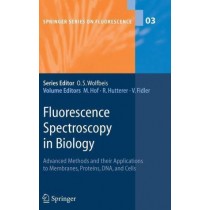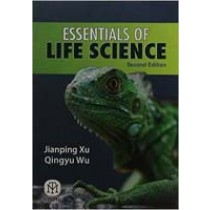Science Books
-

Fluorescence Spectroscopy in Biology: Advanced Methods and Their Applications to Membranes, Proteins, DNA, and Cells: v. 3
Pages: 305,
Specialty: Life Science,
Publisher: Springer,
Publication Year: 2004,
Cover: Hardback,
Dimensions: 155x235x22.86mm
Take any combination of the following features: supramolecular structures with a specific fluorescent probe localized as you would like; nanoscale spatial reso- tion; tailor-made molecular and/or solid-state fluorescing nanostructures; us- friendly and/or high- throughput fluorescence techniques; the ability to do wh- ever you wish with just one single (supra)molecule; utilization of non-linear optical processes; and,last but not least,physical understanding of the processes resu- ing in a (biological) functionality at the single molecule level. What you will then have is some recent progress in physics,chemistry,and the life sciences leading to the development of a new tool for research and application. This was amply demonstrated at the 8th Conference on Methods and Applications of Fluorescence: Probes,Imaging,and Spectroscopy held in Prague,the Czech Republic on August 24th-28th, 2003. This formed a crossroad of ideas from a variety of natural science and technical research fields and biomedical applications in particular.This volume - the third book in the Springer-Verlag Series on Fluorescence - reviews some of the most characteristic topics of the multidisciplinary area of fluorescence applications in life sciences either presendted directly at th 8th MAF Conference or considered to be a cruical development in the field. In the initial contribution in Part 1 - Basics and Advanced Approaches,the - itors explain the basics of fluorescence and illustrate the relationship between some modern fluorescence techniques and classical approaches. The second contrigution by B.show more
Weight: 0.71 KG
Learn MoreAED110.19 -

Field Methods in Marine Science
Pages: 256,
Specialty: Life Science,
Publisher: Taylor & Francis,
Publication Year: 2015,
Cover: Hardback,
Dimensions: 162x240x27mm
Most of the scientific establishment predict that the North Pole will be free of ice around the middle of this century. As Peter Wadhams, the world's leading expert on sea ice, demonstrates in this book, even this bleak assessment of the future is grossly optimistic. Wadhams has visited the Polar Regions more often than any other living scientist - 50 times since he was on the first ship to circumnavigate the Americas in 1970 - and has a uniquely authoritative perspective on the changes they have undergone and where those changes will lead. From his observations and the latest scientific research, he describes how dramatically sea ice has diminished over the past three decades, to the point at which, by the time this book is published, the Arctic may be free of ice for the first time in 10,000 years. Wadhams shows how sea ice is the 'canary in the mine' of planetary climate change. He describes how it forms and the vital role it plays in reflecting solar heat back into space and providing an 'air conditioning' system for the planet. He shows how a series of rapid feedbacks in the Arctic region are accelerating change there more rapidly than almost all scientists - and political authorities - have previously realised, and the dangers of further acceleration are very real. A Farewell to Ice is a report from the frontline of planetary change in the Arctic and Antarctic by a leading authority, presenting incontrovertible scientific data, but always in clear language which the layman can easily understand. It is one of the most important books published in recent years about the existential challenge which human civilization now faces.
Weight: 0.93 KG
Learn MoreAED172.64 -

Exploring Animal Behavior: Readings from American Scientist
Pages: 648,
Specialty: Life Science,
Publisher: Macmillan,
Publication Year: 2010,
Cover: Paperback,
Dimensions: 226.06x269.24x25.4mm
Principles of Animal Behavior has long been considered the most current and engaging introduction to animal behavior. The Third Edition is now also the most comprehensive and balanced in its approach to the theoretical framework behind how biologists study behavior.show more
Weight: 1.43 KG
Learn MoreAED110.19 -

Experimental Design for the Life Sciences 4/e
Pages: 224,
Specialty: Life Science,
Publisher: Oxford UP,
Publication Year: 2016,
Cover: Paperback,
Dimensions: 193x246x11mm
The careful design of experiments lies at the core of good research. Experimental Design for the Life Sciences equips you with the skills you need to effectively design experiments, making this essential aspect of the research process readily understandable. It demonstrates how good experimental design relies on clear thinking and biological understanding, not mathematical or statistical complexity. With a refreshingly approachable and articulate style, the book walks you through the considerations that go into designing an experiment in clear, practical terms. Using examples drawn from across the life sciences - from ecology, biochemistry, molecular biology, genetics, and health sciences - the authors illustrate how these concepts are applied within the broad context of real biological research. Online Resource Centre The Online Resource centre to accompany Experimental Design for the Life Sciences features: For students: * Self-test questions and answers * Additional examples * Supplementary sections discuss complex concepts and statistical issues in more depth * Links to useful websites and free software For lecturers: * Suggested course structures, complete with practical exercises * Figures from the book, available to download show more
Weight: 0.39 KG
Learn MoreAED161.62 -

Evolutionary Analysis, Global Edition, 5e
Pages: 864,
Specialty: Life Science,
Publisher: Pearson,
Publication Year: 2015,
Cover: Paperback,
Dimensions: 217x276x32mm
For undergraduate courses in Evolution By presenting evolutionary biology as a dynamic, ongoing research effort and organizing discussions around questions, this best-selling text helps students think like scientists as they learn about evolution. The authors convey the excitement and logic of evolutionary science by introducing principles through recent and classical studies, and by emphasizing real-world applications. In the Fifth Edition, co-author Jon Herron takes the lead in streamlining and updating content to reflect key changes in the field. The design and art program have also been updated for enhanced clarity.
Weight: 1.84 KG
Learn More -
 AED33.06
AED33.06 -

Essential Forensic Biology Animals Plants and Microorganisms in Legal Investigation
Pages: 304,
Specialty: Life Science,
Publisher: Wiley,
Publication Year: 2007,
Cover: Hardback,
Dimensions: 167.6x246.4x17.8mm
"Essential Forensic Biology" is an introduction to the application of the science of biology in legal investigations. Focusing on the legal system in the UK, the book provides a detailed description of the decay process, and discusses the role of forensic indicators - human fluids and tissues, including blood cells, bloodstain pattern analysis, hair, teeth, bones and wounds. It also considers the role microorganisms, invertebrates and plants play within forensic investigations before considering future directions in forensic science. The book examines the study of forensic biology in cases of suspicious death, and also explores the organisms used in a range of legal investigations; from human and animal neglect to food spoilage, structural damage, the illegal collection/trade of protected species and bioterrorism."Essential Forensic Biology" fills the gap for a resource, which provides information on the range of biological organisms; animals, plants and microbes used in forensic studies. An invaluable introductory text for all students taking forensic science courses, the book features a fully integrated website that covers forensic entomology with additional material and figures from the text to enhance student understanding. The features include: an introduction covering the essentials of forensic biology; features a fully integrated website covering forensic entomology with additional material and self-test questions to reinforce student understanding; each chapter includes a series of questions and topics for further study; and focuses on the UK legal system. From the reviews: "...the numerous black and white photographs, drawings and tables within the book are clear and well deployed." - "Times Higher Education Supplement", 23rd February 2007.show more
Weight: 0.7 KG
Learn MoreAED110.19 -

-

Environmental Plant Physiology
Pages: 160,
Specialty: Life Science,
Publisher: Taylor & Francis,
Publication Year: 2016,
Cover: Paperback,
Dimensions: 134x210x12mm
Plant physiology - the structure of plants- is often perceived as complex and difficult. Yet it need not be. In this comprehensive yet concise guide, we tackle topics in straightforward bite-sized chunks, consolidating each one before moving on to the next. This will save you valuable revision time by helping you to learn more easily and quickly and tackle coursework and examinations with greater confidence. There are 'tutorials' at the end of each chapter to help you improve your learning with practice questions, discussion points, practical assignments and study and revision tips. It is complete with a glossary, a guide to web sites for biology students and a detailed index. This new edition of this book has been specially written for students wanting a clear and concise introduction to this fast-developing field, whether for A and AS Level core and modular courses in Biology, Human Biology and Social Biology, or for first year degree courses in life sciences. It will also be of interest to agriculture and horticulture students and medical and microbiology students.This book explains: water uptake, photosynthesis, respiration, Enzymes and metabolism control, solute transport , plant movements.
Weight: 0.24 KG
Learn MoreAED172.64 -

Environmental DNA For Biodiversity Research and Monitoring
Pages: 272,
Specialty: Life Science,
Publisher: Oxford UP,
Publication Year: 2018,
Cover: Paperback,
Dimensions: 190x248x13mm
Environmental DNA (eDNA) refers to DNA that can be extracted from environmental samples (such as soil, water, feces, or air) without the prior isolation of any target organism. The analysis of environmental DNA has the potential of providing high-throughput information on taxa and functional genes in a given environment, and is easily amenable to the study of both aquatic and terrestrial ecosystems. It can provide an understanding of past or present biological communities as well as their trophic relationships, and can thus offer useful insights into ecosystem functioning. There is now a rapidly-growing interest amongst biologists in applying analysis of environmental DNA to their own research. However, good practices and protocols dealing with environmental DNA are currently widely dispersed across numerous papers, with many of them presenting only preliminary results and using a diversity of methods. In this context, the principal objective of this practical handbook is to provide biologists (both students and researchers) with the scientific background necessary to assist with the understanding and implementation of best practices and analyses based on environmental DNA. show more
Weight: 0.58 KG
Learn More



